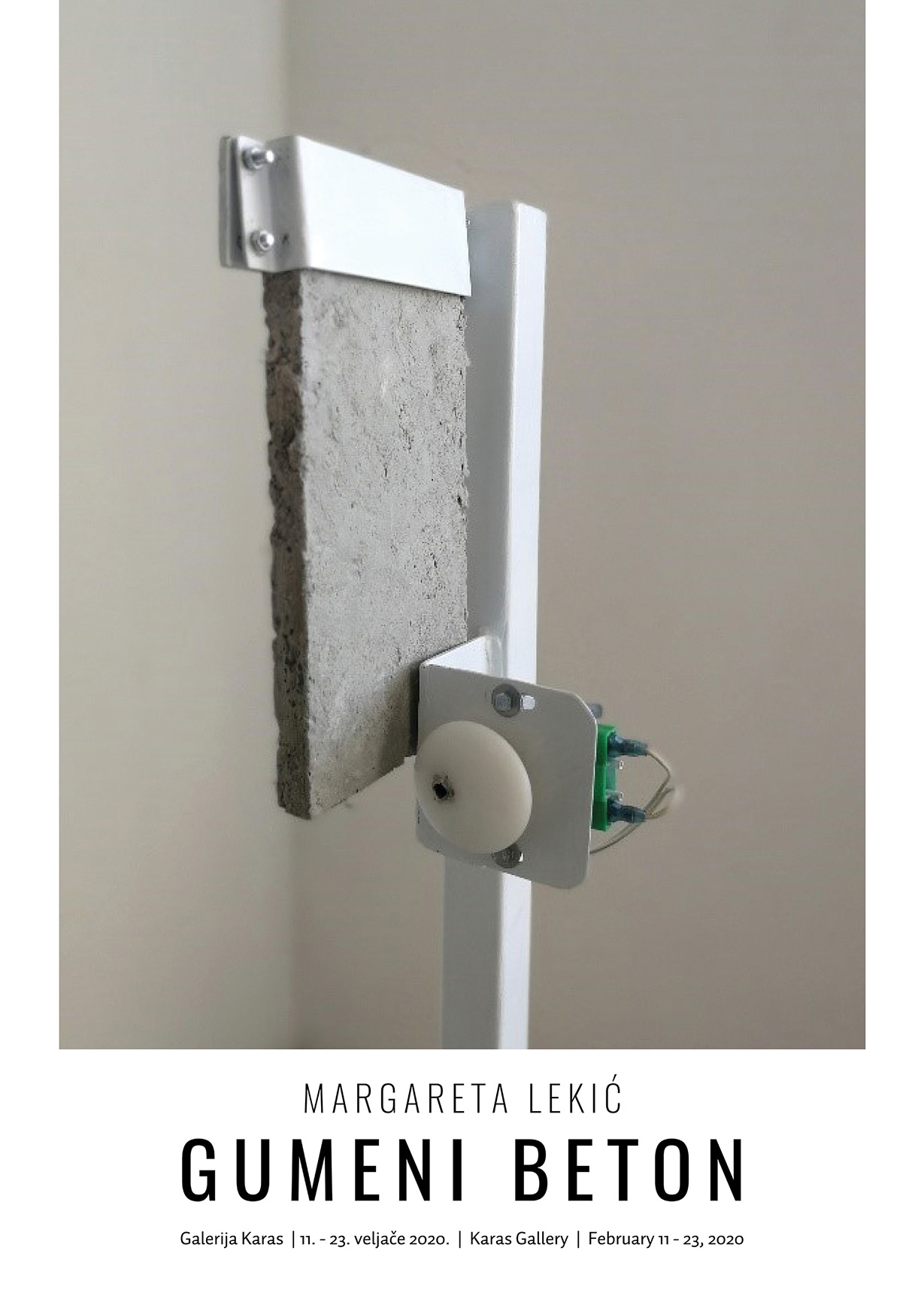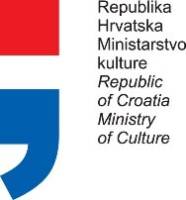EXHIBITION: MARGARETA LEKIĆ – THE RUBBER CONCRETE
MARGARETA LEKIĆ
THE RUBBER CONCRETE
Karas Gallery
February 11 – February 23, 2020

Exhibition The Rubber Concrete, by Margareta Lekić, will be opened on Tuesday, February 11 at 7 pm at the Karas Gallery (Zvonimirova 58). Exhibition is also the public presentation of the artistic part of the doctoral thesis “Redefining Sculpture Using Contemporary Materials” at the Postgraduate Study of the Academy of Fine Arts, University of Zagreb.
Mentors: Prof. Damir Matausic and Ph.D. Margareta Turkalj Podmanicki.
ARTIST STATEMENT
The development of technology and the desire to create new products also result in the creation of new materials. The Gumeni beton (Rubber Concrete) series of works and the new eponymous material were created as a reaction to the inability to access new and innovative solutions in the material manufacturing industry. Searching for an unusually flexible material, I came across a concrete called ConFlexPave, which is rubber under pressure but is not flexible to the extent that it can be restored to its original shape. Since ConFlexPave is not commercially available, I contacted Nanyang Technological University (NTU Singapore), that is, NTU-JTC Industrial Infrastructure Innovation Centre (I³C) to obtain a sample of the concrete for the purposes of my artistic research. I did not get a reply, so I decided to create a new type of material myself, without having any scientific knowledge and expensive laboratory equipment. I created concrete that is rubber in both directions when pressed with hands. However, since I am not a scientist and the material has not been tested in the conditions under which materials are usually tested, I cannot conclude whether this material, a rubber concrete, will be equally flexible even after a certain amount of time has passed. The newly created material, that is, the new type of concrete, has all the characteristics of concrete as a composite material, it consists of cement, gravel, sand, water and additional components that make it flexible.
The Rubber Concrete series of works consists of three sculptures titled Rubber Concrete 1, Rubber Concrete 2 and Rubber Concrete 3. I use the word “rubber” because in everyday language it is common to say that anything flexible is like made of rubber, for example, a physically flexible person is often referred to as “a rubber man“. Therefore, the word “rubber“ in the work’s title does not refer to the physical structure but has a figurative meaning. All three sculptures are in equal proportions, in the correct size ratio. This structure, i.e. the order and correlation in the Rubber Concrete series of works is obvious because all three sculptures are placed in a certain ratio to each other; Rubber Concrete 1 is approximately 40% higher than Rubber Concrete 2, and Rubber Concrete 2 is 40% higher than Rubber Concrete 3. In doing so, I created a proportional relationship, not only between the dimensions of the sculptures but also between the dimensions of concrete slabs. The concrete slab in the work Rubber Concrete 1 is 40% longer and wider than the slab in the work Rubber Concrete 2, and the slab in the work Rubber Concrete 2 is 40% longer and wider than the slab in the work Rubber Concrete 3.
Rubber Concrete 1
– concrete slate: 25x12x1 cm
– sculpture: 140x40x40 cm
Rubber Concrete 2
– concrete slate: 35x17x1,5 cm
– sculpture: 98x48x40 cm
Rubber Concrete 3
– concrete slate: 45x24x2 cm
– sculpture: 70x55x40 cm
Accordingly, a calculation can be made:
SCULPTURE – height extension (h) by 40%
The second sculpture was extended by 40% over the third, i.e.:
h_2=h_3+0.4h_3
h_2=1.4h_3.
Since the first sculpture is 40% higher than the second, the following formula will apply:
h_1=h_2+0.4h_2
h_1=1.4h_2
h_1=1.4∙1.4h_3
h_1=〖1.4〗^2 h_3.
If there were n number of sculptures, formulas to associate their heights with the height of the nth sculpture would read:
h_(n-m) =〖1.4〗^m h_n,
where n is the maximum number of sculptures and m is a growing number of natural numbers.
In particular, if we applied the last mentioned formula to the dimensions of the sculptures in the artwork, it would be:
→for n=3, m=1: h_(3-1)=〖1.4〗^1∙h_3
h_2=1.4∙h_3
h_2=1.4∙70 cm
h_2=98 cm
which is the length of the height of the other sculpture.
The same would be true of the first sculpture as well:
→for n=3, m=2: h_(3-2)=〖1.4〗^2∙h_3
h_1=〖1.4〗^2∙h_3
h_1=〖1.4〗^2∙70 cm
h_2=137.2 cm ≈140 cm
CONCRETE SLABS – height extension by 40% and width extension by 40%
If x denotes the lengths and y the widths of the slabs, then for the 2nd concrete slab which is in relation
to the first one longer by 40% the following formula will apply: x_2=x_1+0.4x_1
x_2=1.4x_1.
For the third slab, which is 40% longer than the second, the following would be true:
x_3=x_2+0.4x_2
x_3=1.4x_2
x_3=1.4∙1.4x_1
x_3=〖1.4〗^2 x_1.
In general: x_n=〖1.4〗^(n-1) x_1,
where n is the number of the concrete slab and x_n the corresponding length of the same slab.
A similar consideration can be applied to the widths of the slabs which we will denote by y, and so for these dimensions a following formula would apply: y_n=〖1.4〗^(n-1) y_1, where n is the number of the concrete slab and y_n the corresponding width of the same slab.
Applying formula to the specified dimensions of concrete slabs in the artwork, we get the following: →for n=2: 〖 x〗_2=1.4∙25 cm=35 cm
〖 y〗_2=1.4∙12 cm=16.8 cm ≈17 cm
→for n=3: 〖 x〗_3=〖1.4〗^2∙25 cm=49 cm
y_3=〖1.4〗^2∙12 cm=23.52 cm ≈24 cm.
ABOUT THE ARTIST
Margareta Lekić was born in Osijek in 1982. She is a member of the Croatian Association of Artists – Osijek and Croatian Association of Artists – Zagreb. She graduated from the Department of Sculpture at the Academy of Fine Arts in Zagreb, where she is currently pursuing her doctoral studies at the same department. She works as an artistic associate at the Academy of Arts and Culture in Osijek. She has won numerous awards and grants. She has studied in the USA, Austria and France. Since 2005 she has had 22 solo exhibitions and has participated in 55 group exhibitions. Margareta has exhibited in Croatia, Europe, the USA, Japan and China.
Organizers:


Supported by:

Working hours:
Wednesday – Friday: 3 pm – 8 pm | Saturday: 10 am to 1 pm
Sundays, Mondays, Tuesdays and holidays: closed.
The exhibition will remain open until February 23, 2020





